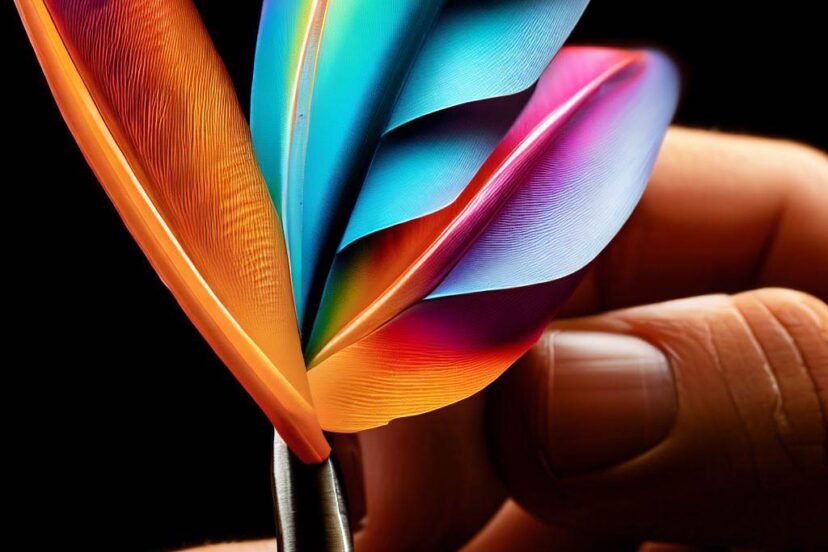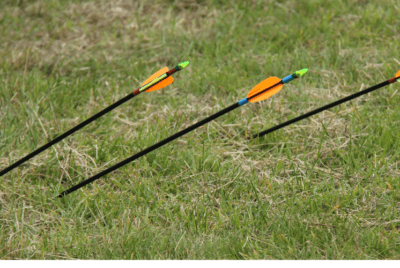Fletching on an Arrow – Creating Stable and Accurate Arrows
Introduction
The art of fletching on an arrow is an essential aspect of archery that can significantly impact arrow flight and accuracy. Fletching, the process of attaching feathers or vanes to an arrow, is both a science and an art. In this article, I will provide valuable suggestions and reasons behind them, guiding you through the world of fletching from the perspective of an archery enthusiast.
What is Fletching?
Fletching refers to the feathers or vanes that are affixed to the rear end of an arrow. These components serve multiple purposes, including stabilizing the arrow during flight, improving accuracy, and optimizing aerodynamics. Fletching has a rich historical significance, dating back to ancient times when archers relied on its functionality to achieve precision in their shots.
Importance of Fletching on an Arrow
The importance of fletching cannot be overstated. Here are some key reasons why fletching is crucial for optimal arrow performance:
- Improved Stability and Accuracy: Fletching imparts stability to the arrow by creating drag, counteracting any imbalances caused by the arrowhead. This stabilization ensures a straighter flight path and enhances accuracy.
- Reduction of Arrow Oscillation: When an arrow is released, it is subject to oscillations due to various factors such as bowstring interference and air resistance. Fletching helps dampen these oscillations, allowing for a smoother and more consistent flight.
- Aerodynamic Benefits: The shape and design of the fletching significantly influence the aerodynamics of the arrow. Properly fletched arrows experience reduced drag, increased lift, and improved downrange performance.
- Effect on Arrow Spin: Fletching induces arrow spin, also known as arrow rotation. This rotation stabilizes the arrow in flight, counteracting any sideways drift and maintaining the arrow’s intended path.
Types of Fletching Materials
There are several materials commonly used for fletching. Each material has its own unique characteristics and considerations. Let’s explore the most popular options:
1. Feathers: Feathers have a long-standing tradition in fletching and continue to be a preferred choice for many archers. Feathers offer a natural option with inherent forgiveness, allowing slight adjustments to the arrow’s flight. They are lightweight, which contributes to arrow speed and stability.

2. Plastic Vanes: Plastic vanes have gained popularity in modern archery due to their durability, consistency, and versatility. They are available in various shapes, sizes, and colors, allowing for customization based on an archer’s preferences. Plastic vanes often offer excellent performance in different weather conditions and are less affected by moisture.

Choosing the Right Fletching
When selecting fletching for your arrows, several factors come into play:
1. Consideration of Bow Type and Arrow Speed: Different bows and arrow setups have varying characteristics that require specific fletching considerations. For high-speed compound bows, stiffer and shorter vanes may be preferred to withstand the arrow’s velocity and maintain stability.
2. Impact of Shooting Conditions: Environmental factors such as wind can affect arrow flight. If you frequently shoot in windy conditions, opt for stiffer vanes or feathers with more surface area to counteract wind drift and maintain accuracy.
3. Experience Level and Personal Preference: The experience level of the archer and personal shooting style play a role in fletching selection. Feathers provide forgiveness and can compensate for slight errors in release and form, making them suitable for beginners. Advanced archers may prefer plastic vanes for their consistent performance and ability to handle different shooting scenarios.
4. Expert Recommendations: Seek advice from experienced archers or bow technicians who can provide valuable insights based on their expertise. They can consider factors specific to your shooting style, equipment, and goals to help you make an informed decision.
Fletching Configurations
Fletching configurations refer to the arrangement of feathers or vanes on the arrow shaft. The two main types of configurations are:
- Straight Fletching: In a straight fletching configuration, the feathers or vanes are aligned in a straight line parallel to the arrow shaft. This configuration is suitable for archers seeking minimal arrow spin and maximum speed. It offers simplicity and ease of application, making it a popular choice among many archers.
- Helical Fletching: Helical fletching involves applying feathers or vanes in a spiraling or helical pattern around the arrow shaft. This configuration induces arrow spin, enhancing stability and accuracy. The rotation created by helical fletching can counteract wind drift and improve downrange performance, making it a preferred choice for target archers and those shooting at longer distances.
Using a Fletching Jig
A fletching jig is a valuable tool that ensures consistent and precise fletching placement. There are two main types of fletching jigs: straight jigs and helical jigs. Here’s a step-by-step guide on how to use a fletching jig:
- Prepare the Arrow Shaft: Before fletching, it’s crucial to clean the arrow shaft thoroughly. Remove any dirt, oil, or residue using alcohol wipes or a clean cloth. A clean surface promotes better adhesion between the fletching and the arrow shaft.
- Choose the Fletching Configuration: Determine whether you want a straight or helical fletching configuration based on your shooting style and preferences. Select the appropriate jig that corresponds to your chosen configuration.
- Secure the Arrow in the Jig: Place the arrow securely in the fletching jig according to the manufacturer’s instructions. Ensure the arrow is aligned correctly and firmly held in place to maintain accuracy during fletching.
- Apply Adhesive: Apply a suitable fletching adhesive to the base of the fletching. The adhesive should provide a strong and durable bond. It’s essential to use the adhesive as per the manufacturer’s recommendations for the best results.
- Attach the Fletching: Press the fletching firmly against the arrow shaft, aligning it according to the desired configuration. Hold the fletching in place for a few seconds to allow the adhesive to bond effectively.
- Repeat the Process: Repeat the fletching process for the remaining vanes or feathers, maintaining consistent spacing and alignment. Take your time to ensure accurate placement and a professional-looking result.
Using a fletching jig simplifies the fletching process, increases efficiency, and produces consistent results, even for beginners.
Applying Fletching
Proper application of fletching is vital to maximize its performance. Let’s delve into a step-by-step guide for applying fletching correctly:
- Prepare the Arrow Shaft: Clean the arrow shaft thoroughly to remove any dirt, debris, or residue. A clean surface promotes better adhesion between the fletching and the arrow shaft.
- Position the Fletching: Determine the desired placement and orientation of the fletching on the arrow shaft. Consider the fletching configuration, shooting style, and recommendations specific to the fletching material you’re using.
- Choose the Adhesive: Select a high-quality adhesive suitable for fletching applications. Consider factors such as drying time, flexibility, and durability. Adhesives specifically designed for archery fletching ensure a secure bond between the fletching and the arrow shaft.
- Apply Adhesive: Apply a thin and even layer of adhesive to the base of the fletching. Ensure that the adhesive covers the entire base area to achieve a strong bond. Avoid excessive adhesive, as it can create messiness and affect the fletching’s performance.
- Attach the Fletching: Press the fletching firmly against the arrow shaft, aligning it according to the desired configuration and orientation. Apply gentle pressure for a few seconds to allow the adhesive to set and bond effectively. Ensure that the fletching is securely attached and aligned correctly.
- Check Alignment and Spacing: Verify the alignment and spacing of the fletching. It is crucial to maintain consistent spacing between each fletching to ensure balanced arrow flight. Use a ruler or measuring tool to ensure accurate and uniform spacing.
- Allow for Proper Drying Time: Follow the manufacturer’s instructions regarding the drying time of the adhesive. It is essential to allow sufficient drying time to ensure a strong bond. Avoid disturbing or manipulating the fletching during this period.
- Inspect and Test: Once the adhesive has fully dried, inspect the fletching for any signs of loose edges or poor adhesion. Gently tug on the fletching to ensure it is firmly attached. Test the arrow’s flight and accuracy to evaluate the performance of the newly applied fletching.
Remember to exercise patience and precision during the fletching process to achieve optimal results. Properly applied fletching enhances arrow stability, accuracy, and overall archery performance.
Common Fletching Problems and Solutions
Despite careful application, fletching-related problems can arise. Here are some common issues and their potential solutions:
- Peeling or Detached Fletchings: If the fletching’s begin to peel or detach from the arrow shaft, it is crucial to address the issue promptly. Clean the arrow shaft thoroughly and reapply the fletching using a high-quality adhesive. Ensure proper alignment and pressure during the application process.
- Worn or Damaged Fletchings: Over time, fletching’s can wear out or become damaged due to use or environmental factors. Regularly inspect your arrows for signs of wear, such as frayed feathers or cracked vanes. Replace damaged fletching’s promptly to maintain accuracy and stability.
- Inconsistent Arrow Flight: If your arrows exhibit inconsistent flight patterns, it could be due to fletching inconsistencies. Check for misaligned fletching’s or variations in fletching angles. Adjust the fletching’s accordingly and ensure consistent placement to improve arrow flight.
- Causes and Solutions: Various factors can contribute to fletching problems, such as improper adhesive application, low-quality fletching materials, or excessive moisture exposure. Address these issues by using high-quality adhesives, opting for reliable fletching materials, and storing your arrows in a dry environment.
Troubleshooting Tips
When faced with fletching-related issues, consider the following troubleshooting tips:
- Identifying the Issue: Carefully analyze your arrow flight patterns and observe any inconsistencies or deviations. Identify whether the problem lies in the fletching, arrow setup, or shooting technique.
- Adjusting Arrow Rest and Nocking Point: In some cases, adjusting the arrow rest or nocking point can alleviate fletching-related issues. Consult with an experienced archer or bow technician to determine the optimal setup for your specific bow and arrow combination.
- Tuning the Bow and Arrows: Proper bow tuning ensures optimal arrow flight and fletching performance. Adjusting the bow’s brace height, draw weight, and cam synchronization can positively impact arrow stability and fletching performance. Consult an experienced archery professional to assist you in tuning your bow and arrows for optimal results.
- Seeking Expert Advice: If you encounter persistent fletching problems or are unsure how to address them, don’t hesitate to seek guidance from experienced archers, coaches, or bow technicians. Their expertise can help identify underlying issues and provide tailored solutions to enhance your fletching performance.
By troubleshooting and addressing fletching-related problems promptly, you can maintain consistent arrow flight, accuracy, and overall archery performance.
Conclusion
Fletching plays a crucial role in the world of archery, significantly influencing arrow stability, accuracy, and aerodynamics. Whether you choose feathers or plastic vanes, the proper selection and application of fletching can enhance your shooting experience.
Consider your shooting style, environmental conditions, and equipment specifications when choosing the right fletching material and configuration. Utilize fletching jigs for precise and consistent placement, and adhere to proper application techniques to ensure a strong bond between the fletching and arrow shaft.
Be aware of common fletching problems and address them promptly to maintain optimal arrow performance. Seek advice from experienced archers and bow technicians when necessary, as their insights can help troubleshoot and improve fletching-related issues.
As an archery enthusiast and advisor, I hope this article has provided you with valuable suggestions and reasons for effective fletching. By optimizing your fletching choices and application techniques, you can enhance your archery skills and enjoy improved accuracy and performance on the field.
FAQs (Frequently Asked Questions)
1.Can I reuse fletchings on my arrows?
Reusing fletching’s is possible, but it is generally recommended to replace them when worn or damaged. New fletching’s ensure optimal performance and accuracy.
2.How often should I inspect and replace my fletchings?
Regularly inspect your fletching’s for wear and damage. Replace them when necessary to maintain consistent arrow flight and accuracy.
3.What is the ideal angle for helical fletching?
The ideal angle for helical fletching varies depending on personal preference and arrow setup. Consult with experienced archers to determine the best angle for your specific needs.
4.Can I fletch my arrows without a fletching jig?
While it is possible to fletch arrows without a jig, using a fletching jig ensures consistent and precise fletching placement, resulting in improved arrow performance.
5. Are feathers or plastic vanes better for fletching?
Feathers and plastic vanes have their advantages. Feathers provide forgiveness and adjustability, while plastic vanes offer durability and consistency. Choose based on your shooting style and preferences.
Remember, practice and experimentation are key to finding the fletching setup that works best for you. Happy shooting!





